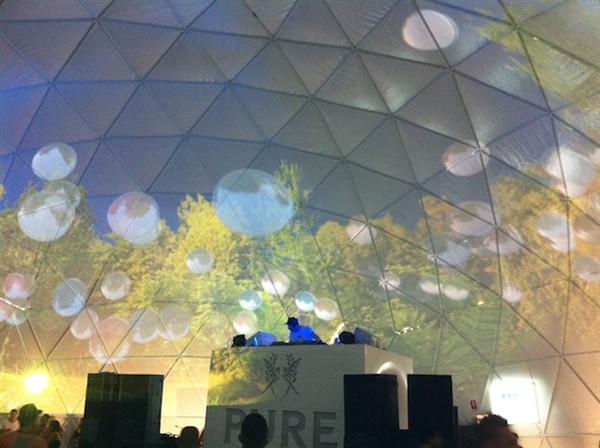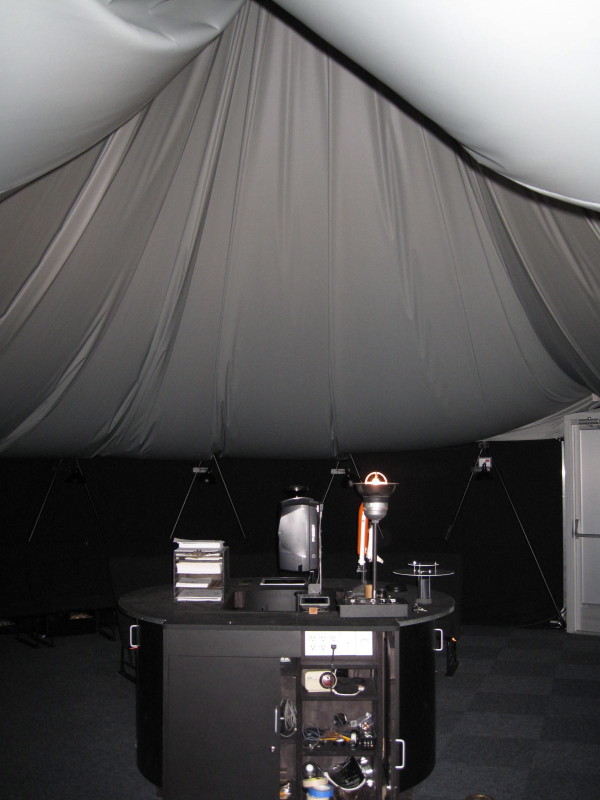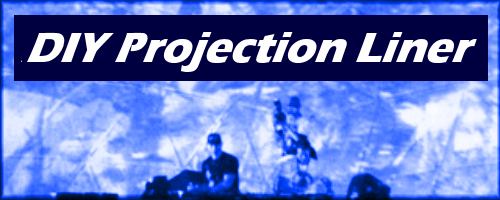Many geodesic event domes suppliers love to sell you on incredibly expensive event solutions. In a niche business it is expected to be expensive, and it almost always is.
But the ultimate waste of money promoted by event dome sellers is the the negative vacuum/pressure projection system.
Those event dome suppliers who will suggest a negative-pressure projection system, a fancy expression for an system holding the projection fabric in place via a vacuum effect, are not offering you the best option for your event.
Many years ago dome sellers started using this patented method, and for a lack of options or most likely laziness, continue to offer it. But it is not the best one out there. A negative pressure/vacuum system is a pretty good solution for smaller domes, but anything bigger than 35 feet (11 meters) is not smart.
And even then, it’s pushing the boundaries of common financial sense. A negative pressure projection liner does do its job, but the majority of sellers demand an unrealistic amount. Why? Because they are very much aware that the liner they rent out may stay in storage a long time until is is used again, and so it is very likely the rental amount is same or more than purchasing the item.

In the image above, projection is displayed on a geodesic event dome’s cover, something that may not be acceptable to clients. The alternative is to use multiple layers of fabric for a smooth, rounded projection surface and to hide the geodesic structure.
Why the negative pressure/vacuum projection system sucks
It consists of three layers of PVC or similar material. You plug in the air blower which creates a vacuum between two layers and the result is a nice rounded shape. If a power outage occurs, your projection surface surface comes down. For outside use, a power backup source can be installed to immediately compensate, but if your dome is located inside and your backup is a generator, it will be very noisy.
The greatest criticism about the negative pressure/vacuum projection system is the cost. A typical solution using this system for a complete 36-foot (11meter) diameter dome will easily set you back $40,000, and this is before shipping, taxes, installation and other related costs. If you would like to see more pictures of the negative pressure/vacuum system, visit the St-Lawrence Hall of Science planetarium website.
- Click to enlarge
Many dome sellers are snobs
If you mention inflatable domes to a metal conduit dome seller they will have a prepared list of criticism regarding them. In addition, they know very little about inflatable domes other than they require air to be set up. Why?
- Inflatables are the products that can compete with metal domes.
- Most inflatable domes are manufactured in Asia, and so costs tend to be much lower than metallic domes. Also, geodesic covers are much less expensive.
- Inflatable domes do not require as much technical expertise and equipment to set up, and this cuts into the metal event dome seller’s profit margin.
Inflatable domes are far from perfect:
- If the power goes out the structure deflates
- It requires a very firm attachment to the ground
- Not all inflatable have nice rounded shapes for good projection results.
These issues are not difficult to address, though traditional event dome sellers will repeat them continuously because it is their natural competitor. The solution for the client or end user is a hybrid one.
So what is the alternative?
In short: consider a traditional inflatable projection dome inside a traditional geodesic structure. These are inflated like a giant balloon, and their interior surface is often designed for projection.
Stay away from inflatables which inflate the inside of the dome to stay up (ex: soccer domes). The right choice is a dome which inflates its wall to remain upright. This way there is no need to keep the dome sealed at all times.
If you opt for the inflatable projection solution, be aware there are varying degrees of quality and construction; for example, one inflatable may have a much smoother surface than another.
A variation on the negative pressure concept is available by clicking on the banner below:
Two solution: one sucks and the other blows?
The difference is a lot of money, and we mean a lot of valuable money. Expect an inflatable dome to be less than half the cost of the negative pressure/vacuum system (most suppliers are sourced from Asia). To secure the inflatable dome, put it inside a geodesic dome structure. Funny thing: that is exactly what is done for negative pressure systems. but at a much higher cost.
Not only will you save large amounts of money, but it would be easy to store the inflatable dome for future events. If you believe negative projection liners are the best fit for you, consider clicking on the banner above for a solution about half the price of what dome sellers offer.




